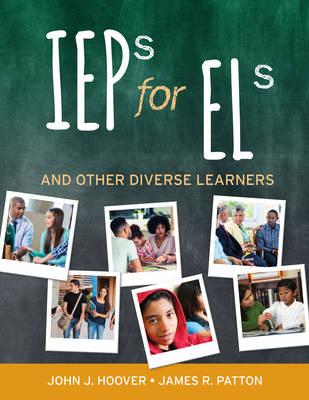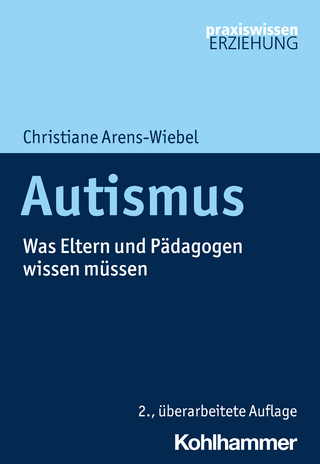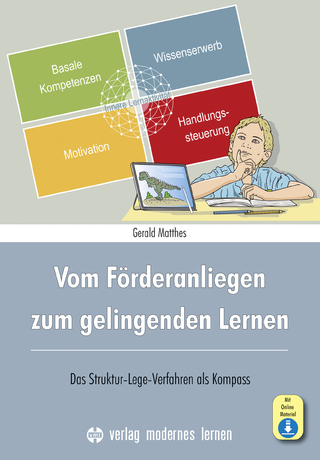
IEPs for ELs
Corwin Press Inc (Verlag)
978-1-5063-2818-8 (ISBN)
Develop and monitor high-quality IEPs for diverse learners
High-quality IEPs are fundamental for guiding the educational process of and developing goals for students who require special education services. English learners (ELs) and other students with learning, emotional, or behavioral disabilities present unique challenges to educators responsible for referring, assessing, and placing them. IEPs for ELs provides educators with numerous research-based strategies and examples of how to write effective IEPs for these K-12 learners.
John J. Hoover and James Patton, leading professionals in the areas of special education and linguistic diversity, share their research and how they have supported ELs who have, or are suspected of having, learning and intellectual disabilities. Readers will find:
Practical guidance for developing and monitoring culturally and linguistically responsive IEPs
Checklists, guides, and other reproducibles that support IEP development
Case studies and vignettes highlighting examples of appropriate IEPs for diverse learners
Filled with expert practical advice that covers the IEP process and walks the reader through the procedure for creating high-quality IEPs that take individual differences into account, this guide is essential for special educators and bilingual/EL specialists.
"A major strength for this book is its unique tie to English learners, while providing a dual focus on IEP writing. This is a great tool to use when training new special education teachers and IEP facilitators. There are direct connections to writing legally defensible plans with a user-friendly focus on IEP writing. I see this book as a tool to support teachers and students in ensuring that language and cultural considerations are included when developing and updating individual plans."
—Renee Bernhardt, Supervisor, Special Education
Cherokee County School District, GA
John J. Hoover is Associate Research Professor at the University of Colorado Boulder and a former K–12 special educator, teaching diverse students representing multiple languages and cultures in western, southwestern, and mid-western states. He earned a BA in Elementary and Special Education (Intellectual Disabilities), an MA in Learning Disabilities and Emotional Disorders with an emphasis in Reading, and a PhD in Curriculum specializing in Special Education. His research agenda for the past two decades has focused on the topic of culturally and linguistically responsive special education referral and assessment of English language and other diverse learners. He is currently PI on a multi-year grant funded project addressing ELs and multi-tiered supports, special education referral and assessment of culturally and linguistically diverse learners, and graduate level teacher preparation for teaching English language and other diverse learners with and without disabilities. Select recent coauthored/coedited books include: Why do English learners struggle with reading: Distinguishing language acquisition from learning disabilities (Pearson); Linking assessment to instruction in multi-tiered models: A teacher’s guide to selecting reading, writing and mathematics interventions (Pearson); Differentiating learning differences from learning and behavioral disabilities: Teaching diverse learners through multi-tiered response to intervention (Allyn & Bacon); and Methods for teaching culturally and linguistically diverse exceptional learners (Pearson Merrill). He also is co-author of a nationally normed reading test, Early Reading Assessment (Pro-Ed), and of a research-based educator self-assessment and professional development tool, Core ESL Instructional Practices (CEIP) Guide. Recent referred journal publications include: Increasing usage of ESL instructional practices in a rural county elementary school, Rural Educator (2015); Culturally responsive special education referrals of English learners in one rural county school district: Pilot project, Rural Special Education Quarterly (2015), and Reducing unnecessary referrals: Guidelines for teachers of diverse learners, Teaching Exceptional Children (2012).
Acknowledgments
About the Authors
About the Contributors
Introduction: Blueprint of IEPs for ELs and Other Diverse Learners
Underlying Assumptions of the IEP Development Stage
Topical Areas and Terminology
Chapter 1: Understanding a Culturally and Linguistically Diverse Multi-Tiered System of Supports
Practitioner’s Perspective
Overview of MTSS
MTSS and Cultural and Linguistic Diversity
Culturally and Linguistically Responsive Teaching Qualities
What Makes an IEP Culturally and Linguistically Responsive?
Educational Framework for Diverse Learners With Disabilities
IEP Development Principles for English Language and Other Diverse Learners
Conclusion
Chapter 2: Essential Components of IEPs for English Language and Other Diverse Learners
Practitioner’s Perspective
Required Components of IEPs per IDEA
Other Mandated IEP Considerations per IDEA
IEP Team: Essential Members for Diversity
Conclusion
Chapter 3: Role and Function of Academic Language in IEPs
Practitioner’s Perspective
Academic Language Historical Perspective
Academic Language Processes
Inclusion of Academic Language Proficiency in IEP Development
Conclusion
Websites
Chapter 4: Culturally and Linguistically Responsive Present Levels of Academic Achievement and Functional Performance: Determining Accurate Levels and Developing Meaningful Statements
Practitioner’s Perspective
What Are PLAAFP and Why Are They Important?
Creating Meaningful PLAAFP Statements Using the CRISEN Principles
Examples of Meaningful and Instructionally Relevant PLAAFP Statements
Developing Responsive and Defensible PLAAFP
Conclusion
Chapter 5: IEPs and the Development of Measurable Annual Goals Using SMART Principles
Practitioner’s Perspective
Introductory Considerations
What Is a SMART Goal?
Examples of SMART Goals
Developing SMART Goals
Making SMART Goals Culturally and Linguistically Responsive
Conclusion
Chapter 6: Delivering Appropriate IEP Services
Practitioner’s Perspective
English Language Development and IEP Implementation
Addressing Language and Content During Instruction for English Learners
Implementing the IEP
Conclusion
Chapter 7: Special Considerations and Diversity
Practitioner’s Perspective
Supplemental Aids/Services for Diverse Learners
Accommodations and Modifications
Assistive Technology and Services
Functional Behavioral Assessment and Behavioral Intervention Plans
High Stakes Assessment, Diversity, and IEPs
Conclusion
BIP-3: Functional Behavioral Assessment (Sample)
BIP-3: Behavioral Intervention Plan (Sample)
Chapter 8: IEP Progress Monitoring and Diverse Needs
Practitioner’s Perspective
Progress Monitoring Defined and Overview
Culturally Responsive Monitoring Competencies
Progress-Monitoring Practices
Progress-Monitoring Interpretation for Diverse Learners: Special Considerations
Conclusion
Chapter 9: Culturally and Linguistically Responsive Transition Planning and Services
Practitioner’s Perspective
Successful Adult Functioning
Basic Concepts Associated With Transition Planning and Services
Transition Planning for Culturally and Linguistically Diverse Students
Conclusion
Chapter 10: Guidelines for Successful IEP Meetings for Diverse Learners
Practitioner’s Perspective
Importance of Funds of Knowledge in Education
Pre-Meeting Suggestions
During–IEP Meeting Suggestions
Post-Meeting Suggestions
Conclusion
Chapter 11: Putting the IEP Pieces Together
Summary of IEP Skill Sets for English Language and Other Diverse Learners
The Integrated IEP for Diverse Learners
Conclusion
Appendix
Commercially Available Instruments for Determining Present Levels of Performance
Elementary Individualized Education Program (Sample)
Secondary Individualized Education Program (Sample)
References
Index
| Erscheinungsdatum | 04.05.2017 |
|---|---|
| Verlagsort | Thousand Oaks |
| Sprache | englisch |
| Maße | 215 x 279 mm |
| Gewicht | 600 g |
| Themenwelt | Sozialwissenschaften ► Pädagogik ► Sonder-, Heil- und Förderpädagogik |
| ISBN-10 | 1-5063-2818-0 / 1506328180 |
| ISBN-13 | 978-1-5063-2818-8 / 9781506328188 |
| Zustand | Neuware |
| Haben Sie eine Frage zum Produkt? |
aus dem Bereich


